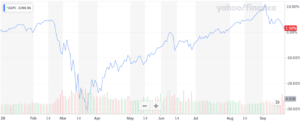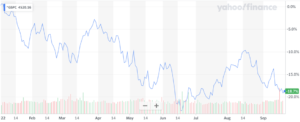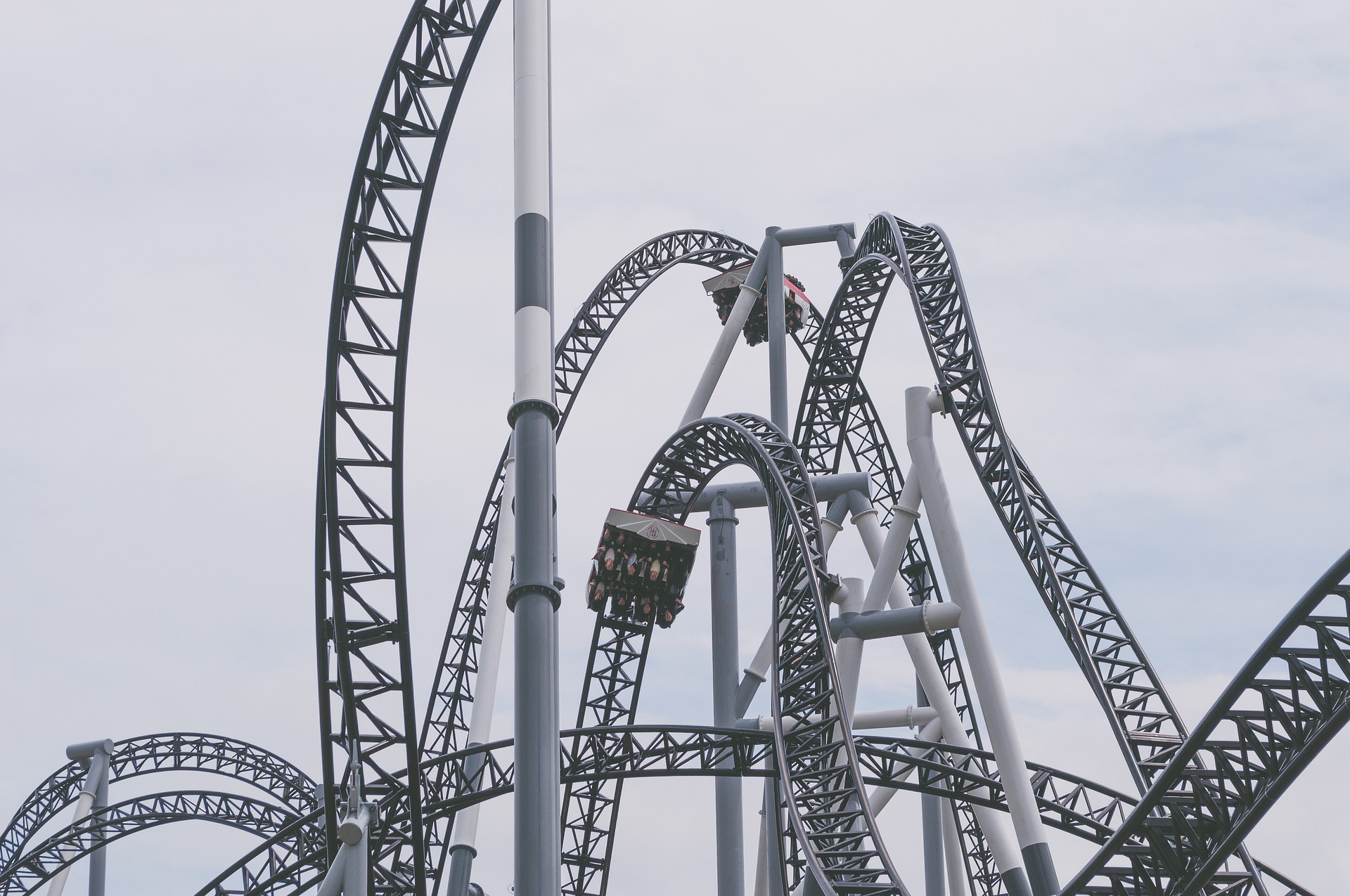To say it’s been a tough year for investors is probably an understatement. If you’re feeling weary of “holding tight” or “being patient” with this market, you’re not alone. Financial Planning Magazine reports “the willingness of investors to stomach market losses” fell from a score of 57.8 in June 2021, to a score of 25.6in June of this year – it’s lowest score in the 11-year history of the survey performed by Arizent Research. I’ve observed the same trend in sentiments among many of my clients as well.
Not All Bear Markets Are Alike
While the market has seen bigger losses as recently as 2020, this year feels different. But why? Mostly, I think it’s just a matter of duration.
Here’s a picture of 2020 through 9/21:

Source: Yahoo! Finance
While the market suffered a 34% drop in the early part of the year, as you can see, it had completely recovered by September. If you remember, March of 2020 was a very scary time to be an investor. We were worried about most of the economy being completely shut down indefinitely. But at the end of the day, the crash was so short lived – and we were distracted by a more immediate threat to our health – that investors hardly had a chance to think about abandoning their investment strategy. By the time we blinked the market had recovered and no harm was done.
Contrast that experience with this year. At its low in mid-June, the S&P 500 was down about 23%. That’s 1/3 less of a drop than in 2020! Can you believe that? I don’t think anyone feels that way. Why not? Here’s the chart from this year:

Source: Yahoo! Finance
While 2020 was a furious drop, followed by a quick and almost uninterrupted rebound, this year we have experienced several smaller drops followed by “false” recoveries.
Trying to Time the Market Is Almost Irresistible
This sort of pattern eats away at investors’ resolve. Why? For one, it is human nature to try to predict the future. When we hear things on tv or read something online about inflation or interest rates or wars or politics, our instinct is to try to interpret what that means for our portfolios (or sometimes the talking heads interpret it for us).
So, we hear some negative news, and predict that, while the market has already fallen, it’s going to fall even more.
In a year like 2020, we were proven wrong. Even though COVID-19 was harming millions and the economy was largely shut down, somehow the stock market came roaring back. Thank goodness we stayed the course!
On the other hand, in 2022 we’ve been proven right. All our fears are coming true. We knew it was going to happen and it did! Each time this prediction/confirmation cycle happens (and it’s been several already this year) our confidence in our (or our favorite pundit’s) ability to predict the future increases and our resolve to stay the course weakens. We’ve been right several times this year, and we’re still hearing bad news, so we can’t just “trust the process” anymore. We “know” the market has farther to fall.
How Our Instincts Can Fail Us
Here’s the problem: markets aren’t predictable. They just aren’t. Sometimes they feel like they are. Sometimes we get years like 2022, when the market falls, and then falls a little more, and then falls a little more. Looking back with hindsight, investors should have pulled out of stocks at the end of last year.
But what about 2020, when the future looked just as bleak (or arguably even more), but then rebounded right in the middle of a global pandemic?
What about the end of 2018 when the S&P 500 fell 20% in just 2 months, and then bounced back generously in 2019?
Sometimes bear markets are quick, sometimes they are slow. That doesn’t mean it’s worth trying to predict which type we’re in.
Changing your investment strategy AFTER a market drop is rarely a good long-term move. But sadly, that’s what many investors are doing. In that same survey by Arizent Research, advisors reported investors moving from an average of about 65% stocks to just 40% over the past year. This instinct to get out when things look uncertain and back in when things are “more stable” has been dubbed the “Behavior Gap” and costs investors in the range of 1-4% per year.
Think of the irony. If something at the grocery store drops in price, you don’t buy less of it, you buy more. That’s how we respond to prices in every other aspect of our lives.
And yet, because of what I described above, we tend to want to do the opposite with our investments. But we have to fight against our instincts in this case.
Three Questions For a Bear Market
I find it helpful to go back to the most basic investing principles:
- Do you believe that you will be rewarded in the long run for investing? The stock market has historically rewarded investors for providing capital to businesses who need it – to the tune of about 10% per year when we look over long time periods. Having a belief in the long-term potential of markets is essential for being able to stay disciplined during temporary down markets. If you’re struggling answering yes to this one, here’s some further reading.
- Does your investment allocation match your time horizon? What I really mean here is, do you need the money you have invested in the stock market anytime soon? If so, you should revisit your allocation and make sure you have enough short-term investments to take care of any short-term needs. This will free you to let your long-term stock market investments be measured on a long-term basis, rather than worrying about the short-term ups and downs.
- Do you believe you can time the market? I find in a vacuum most investors answer “no” to this question because they know in theory it is true. But at times like these (again for the reasons described above) many find it irresistible to predict that the market will continue to fall. However, the answer to whether you can time the market is always and for everyone “no”. You can’t time the market. I can’t time the market. Even the smartest professionals on Wall Street can’t do it consistently. That doesn’t mean no one has ever made a correct prediction (even in games of chance people sometimes guess correctly). It means that correct predictions about the market can’t be made consistently enough to make it worth trying. Here’s more to read on this subject
The Right Approach to Investing
If you answered yes, yes, and no, to the above three questions, then the path ahead is simple. Not easy, but simple.
If designed properly, your financial plan doesn’t depend on you avoiding every down market. It depends on you capturing the long-term upward trend. And the best way to accomplish that is to buy and hold, stay diversified, and don’t react to market volatility or the news.
Imagine a world where you don’t have to worry about what is going on in the markets. You don’t have to listen to what the pundits are saying. You can just live your life, knowing that you are well positioned to capture the returns of the market over the long run and to meet your financial goals.
I think this is what every investor should be striving for. It’s not only the best investment strategy, but also the best strategy for your quality of life and peace of mind.

